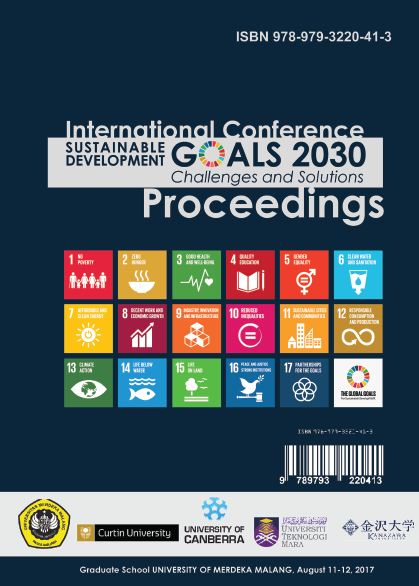The Effect of Social Capital on Household Poverty Reduction in Gorontalo Province
DOI:
https://doi.org/10.26905/icgss.v9i1.15759Keywords:
Social Capital, Poverty, HouseholdAbstract
This study uses quantitative research methods with OLS (Ordinary Least Squares) data analysis techniques and Simple Linear Regression Analysis. One of the causes of household poverty is economic activities that meet various needs for goods and services. The commodity consumed is one of the indicators of household/family welfare. The data used in this study is SUSENAS data from 2021, which includes social capital for reducing household poverty in the Gorontalo Province area. In this study, the results of the analysis showed that social capital had a negative but not statistically significant effect on household poverty. On the other hand, the length of schooling, age, marital status, number of household members, and floor area have a positive and statistically significant influence on household poverty. Meanwhile, gender, business credit, primary employment, and housing status did not have a statistically significant effect on household poverty.
Downloads
References
Amalia, A. D. (2015). Modal Sosial Dan Kemiskinan Social Capital and Poverty. Sosio Informa, Puslitbang Kemensos RI, 1(3), 1–14. https://ejournal.kemsos.go.id/index.php/Sosioinforma/article/download/166/108
Asadi, A., Akbari, M., Fami, H. S., Iravani, H., Rostami, F., & Sadati, A. (2008). Poverty Alleviation and Sustainable Development: The Role of Social Capital. Journal of Social Sciences, 4(3), 202–215. https://doi.org/10.3844/jssp.2008.202.215
Elza Fitri, R., Setiawan, E., Usman, M., Dorrah Aziz, and, & Ir Sumantri Brojonegoro Bandar Lampung City, J. (2022). Analysis of Binary Logistics Regression on Poverty Depth Index Data in Indonesia in 2020. Journal of Siger Mathematics, 03(02), 69–74.
Faruk, F. M., Faruk, F. M., Doven, F. S., & Budyanra, B. (2020). Application of the Binary Logistics Regression Method to Determine the Determinants of Household Preparedness in Facing Natural Disasters. National Seminar on Official Statistics, 2019(1), 379–389. https://doi.org/10.34123/semnasoffstat.v2019i1.146
Ferezegia, D. (2018). Poverty Level Analysis. Journal of Applied Social Humanities, 1(1), 1–6. http://journal.vokasi.ui.ac.id/index.php/jsht/article/download/6/1
Jacobus, E. H., Kindangen, P. ., & Walewangko, E. N. (2019). Analysis of Factors Affecting Household Poverty in North Sulawesi. Journal of Regional Economic and Financial Development, 19(7), 86–103. https://doi.org/10.35794/jpekd.19900.19.7.2018
Kadji, Y. (2004). Poverty and its Theoretical Concepts. 1–3.
Kusumastuti, A. (2016). Social Capital and Adaptation Mechanisms of Rural Communities in Infrastructure Management and Development. SOCIETY: Journal of Sociology, 20(1). https://doi.org/10.7454/mjs.v20i1.4740
Nasution, A. (2017). Social Capital Formation and Poverty Reduction Policies in Rural Households in Indonesia. Journal of Economics and Public Policy, 7(2), 171. https://doi.org/10.22212/jekp.v7i2.672
Novytha, T. (2019). The Role of Social Capital in Improving the Welfare of Underprivileged Families in Pallangga District, Gowa Regency. Development Economics, 1–15.
Nyoman Yuliarmi, N., MarhaeniN Saskara, I. A., Arka, S., & P Wiagustini, N. L. (2017). POVERTY ALLEVIATION IN BALI PROVINCE (Reviewed from
Aspects of Social Capital and the Role of Customary Institutions). IX(1), 34–43.
Pratama, Y. C. (2019). Analysis of Factors Affecting Poverty in Indonesia. Journal of Public Administration and Business, 1(2), 1–8. https://doi.org/10.36917/japabis.v1i2.9
Santoso, T. (2020). Understanding Social Capital. In Understanding Social Capital. http://repository.petra.ac.id/18928/
Saputri, A. (2021). Social Capital and Household Poverty in Indonesia. Jurnal Kawistara, 11(3), 252. https://doi.org/10.22146/kawistara.v11i3.66012
Suyriawati, C. (2010). Understanding poverty in a multidimensional way. Proceedings - European Aviation Safety Seminar, EASS, 08(03), 585–597.
Taga, A. A. (2013). Social Capital and Poverty Alleviation ; Some Qualitative Evidences from Lahore District. International Journal of Basics and Applied Sciences, vol 1(3), 681–693.
Yuhadisi, S., & Suliadi. (2021). Application of the Hosmer-Lemeshow Test Modification Method on the Logistic Regression Model of Data of Hypertensive Disease Patients. Proceedings of Statistics, 7(1), 50–55.
Saputri, A. (2021). Social Capital and Household Poverty in Indonesia. Jurnal Kawistara, 11(3), 252. https://doi.org/10.22146/kawistara.v11i3.66012
Downloads
Published
How to Cite
Issue
Section
License
Copyright (c) 2025 Proceedings of International Conference of Graduate School on Sustainability

This work is licensed under a Creative Commons Attribution-ShareAlike 4.0 International License.
Authors who publish in this journal agree to the following terms: Proceeding of International Conference of Graduate School on Sustainability is licensed under Creative Commons Attribution-ShareAlike 4.0 International. Creative Commons Attribution-ShareAlike 4.0 International License (CC BY 4.0) is applied when mandated by research funders, such as those who have signed. Open Access articles in Jurnal Cakrawala Hukum are published under theCreative Commons Attribution-ShareAlike 4.0 International (CC BY 4.0) license. The copyright of the received article shall be assigned to the journal as the publisher of the journal. The intended copyright includes the right to publish the article in various forms (including reprints). The journal maintains the publishing rights to the published articles. Authors must agree to the copyright transfer agreement by checking the Copyright Notice column at the initial stage when submitting the article.









